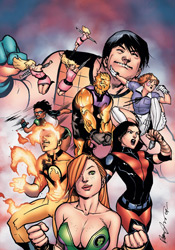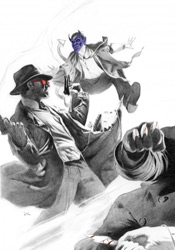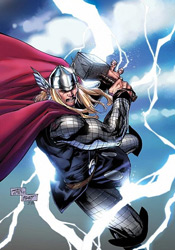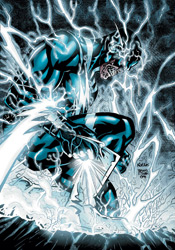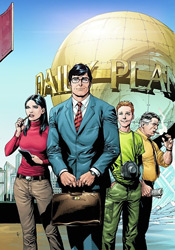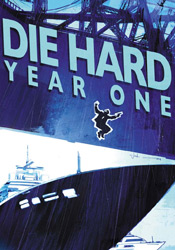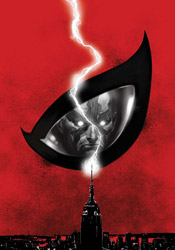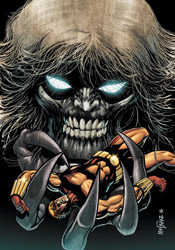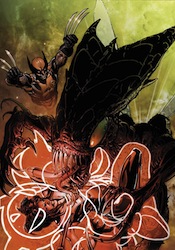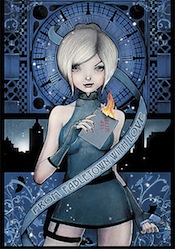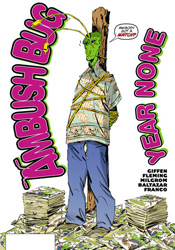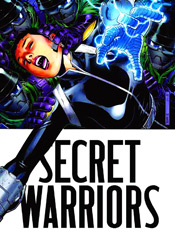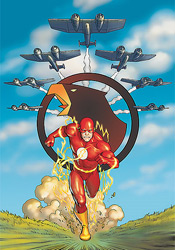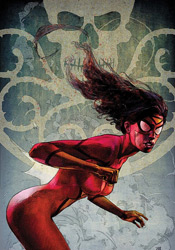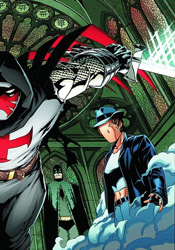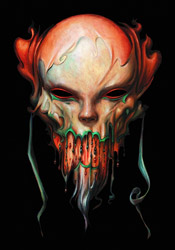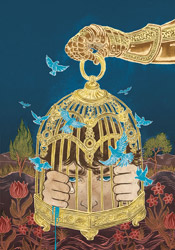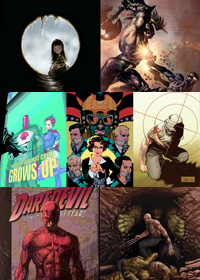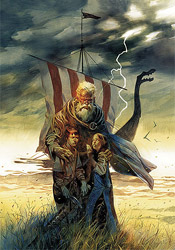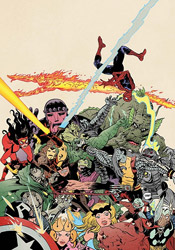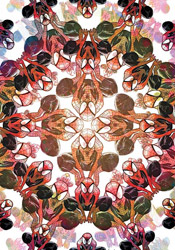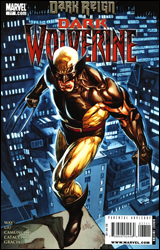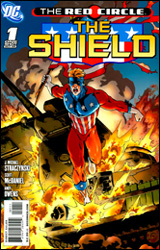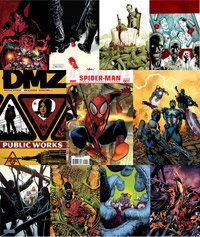A quick glimpse at what else I've been reading this month...
Dark Avengers #7 - I hate crossover tie-ins. I especially hate when I don't know they're coming, and it really rises my ire when they interrupt a book that's been rolling along as well as
Dark Avengers has been. With that said, I'm usually quick to forgive in such situations and I generally like what I've seen from Matt Fraction, but this was total crap. The vast majority of this issue was spent introducing generic characters I've never heard of, half of which were then promptly knocked off or knocked out in an orgy of superpowered glee and randomly exploding city streets. What was the point of that?! Honest to god, I thought I'd returned to the early '90s for a sort of X-Cutioner's Song Redux. The few nuggets of goodness that were scattered around this issue weren't nearly enough to compensate for its flavorless artwork and disconnected approach to the Avengers themselves.
2/10The Walking Dead #63 - Even when it's treading water, this series is more entertaining than most titles experience during their greatest arcs. I'm constantly astonished at how effortlessly Kirkman can integrate deep new personalities to
Walking Dead's roster. They're each multi-dimensional, inherently flawed, genuinely compelling individuals, and the writer casually slides their tales into the flow of the story as though they were nothing. This month we're learning a bit more about Gabriel, the priest who strolled into the group's life a few issues ago, and he fits that mold just as well as those who came before. I felt like the ending of the issue was somewhat telegraphed, but that doesn't make it any less harrowing or ominous for the near future of Rick and his cluster of survivors. Once again, this is great storytelling from both writer and artist, intense characterization and a sudden zombie attack or two thrown in to make sure we don't forget about the big picture. I'm glad I jumped on to enjoy the ride.
8/10Chew #1 - Well, that was imaginative if nothing else. This issue changed gears and directions so many times that by the last page I felt dizzy. Is it a crime drama? An open discussion about the treatment of America's poultry? A rant against prohibition? Maybe a bit of science fiction with a hint of superheroism? It's all and none of the above, like the creators couldn't decide on a specific direction and instead chose to pursue everything that came to mind. I enjoyed certain aspects of the story, like the premise that chicken was outlawed by our government after a particularly nasty bout with the bird flu, but really found myself at a loss when it came to others. I'll give John Layman, the writer, points for originality; I've never seen a power quite like Tony Chu's ability to learn everything about a creature by ingesting it. There's a lot of potential for ingenuity there, but to be frank I'm not particularly taken by the direction. It's playful, but lacking. I loved Rob Guillory's artwork, though, which matched the manic, odd flavor of that storyline beat for beat. If you're a fan of Jim Mahfood, you'll like Guillory's work too.
4/10The Walking Dead Volume 1: Days Gone Bye - Finally got my hands on the first volume, and tore through it in one sitting. I was worried I'd be distracted by Tony Moore's initial interpretation of the characters, since I got to know them in the hands of Charlie Adlard, but instead found the two artists' styles to be very compatible. I was struck by the much faster pace of this chapter, especially compared to the current arc, but looking back that's understandable. The cast hadn't really figured out what they were doing yet, so it's only natural that they'd come under fire (so to speak) with much more regularity than they do now. I thought the friendship / rivalry of Rick and Shane made a great outline for this first arc, before being effectively cast aside at its conclusion, like a pair of training wheels. For all the growing the cast did in this arc, they've got a long ways to go before becoming the hardened, jaded faces we're following today. It's nice to have a little perspective now. Great reading.
10/10DMZ Volume 3: Public Works - Another fine volume, if lacking the sharp direction and focus of the first two trades. With such a tremendous supporting cast already established, Brian Wood may have been overextending himself by introducing a whole new roster for Matty to interact with in this arc, because the new faces really pale in comparison. Amina, the only one I could imagine making a return visit, is so shallow and indecisive, it's hard to comprehend how she manages to survive at all. It probably sounds like I'm coming down on this really hard, but that really isn't my intention. It's just an unusually linear storyline. Books one and two were moving a thousand miles an hour in a million different directions, and I came to adore that frenetic personality. Public Works, by comparison, is wearing a small pair of horse blinders and charging straight ahead.
DMZ's constant parallels to the current political climate may date it in the coming years, but it still feels relevant today, two years after publication. Riccardo Burchelli's artwork remains gritty, flavorful and delicious. I'd buy the rest of the trades for his work alone.
7/10Ultimate Comics Spider-Man #1 - I guess the huge, world-shaking ramifications of Ultimatum have resulted in... a return to the status quo, more or less. Which isn't necessarily a bad thing since
Ultimate Spider-Man has consistently been one of my favorite monthly books. It's just a little weird to step in expecting black to be white and up to be down, only to be confronted with an almost-direct continuation of the storyline virtually right where we left it. Bendis is good for a few really fun bits of dialog, as always, and he has actually changed some minor details (like Parker's choice in lady friends) but this didn't really sell me on the need to relaunch the series with a new number one. I didn't care for David LaFuente's take on the famous webbed threads, but the rest of the issue looked decent enough. I'll give him some time to grow on me.
7/10Ultimate Comics Avengers #1 - This read like even parts
Ultimates 2 and
Ultimates 3, which is perplexing since I didn't really imagine Millar would want anything to do with the latter. The team is amazingly thin, basically just Cap and Hawkeye with Fury and Stark making brief cameos, but they didn't need much more for the purposes of this issue. Remember when the Widow and Hawkeye were leaping between skyscrapers, shooting down helicopters and KOing terrorists a few years ago? The majority of this chapter is an extended rehash of that scene, with good ol' Captain A taking the lady's place and a super cheesy, overthought rendition of the Red Skull standing in as the evil mastermind. If it were a movie, this would be a popcorn chomper, if not an especially deep one. Color me disappointed.
4/10The Walking Dead #64 - The requisite bi-monthly storm between calms. Holy crap, every time this series seems like it's slowing down or heading in a remotely predictable direction, it jukes ferociously and leaves me wondering where my center of gravity went. I'm running out of adjectives for Kirkman and Adlard's masterpiece, and issues like this one are the reason why. Constant action, relentless suspense, fantastic characterization and fundamentally perfect artwork. Who could ask for anything more? Keep 'em coming, boys, and I'll keep buying.
10/10Ex Machina #44 - The secret origin of the Great Machine was honestly pretty surprising, so as it turns out Brian K. Vaughan actually does know how to follow through on a good premise from time to time. As usual, the big reveal asked more questions than it answered, and still found the time to completely wig the fuck out on me once or twice. So... there's just a giant gleaming cube underneath the helmet of the Big Daddy that's been wandering the NYC sewers for the last six months? What?! And what's with Bradbury going nutso and playing teeball with a reporter's noggin right in the middle of a conversation? I mean, in retrospect I've got a few ideas about how the two might be related, but at the time I thought somebody had snuck some LSD into my toothpaste or something. An interesting twist surrounded by a nice big glob of WTF.
5/10Batman and Robin #3 - I'm still having a hard time deciding what I think of this series. Well, scratch that, I'm having a hard time figuring out what to make of the writing, because Quitely's artwork is freaking phenomenal. Every month he's exploring new territory in creative storytelling, inventive integration of sound effects and unsettling characterization. He's a master of his craft, and Morrison, believe it or not, is mostly just along for the ride. I can't imagine this storyline working with another artist, but work it does, with a few well-placed nods to the classic
The Killing Joke thrown in for good measure. This tour of the deranged inner workings of a local sideshow was lots of fun, although it was also quite a bit more skewed than I'm used to seeing from one of DC's big guns. I guess the time's right to try out a few new ideas with these characters, what with the change in protagonists and accompanying editorial leniency. All right, the jury's in, I've decided to like it.
8/10Dark Avengers #8 - Complete garbage. I should've known better than to buy it after last month's sneak preview, but like a good little reader I had to go and give it another chance. It was nice of them to shrink the "Dark Avengers" typeset on the cover, because the team itself enjoys maybe four panels of attention from front to god-forsaken back this month. The rest of the time we're celebrating Emma Frost's public speaking in the middle of a flashy, hyperactive mutant throwdown. Listen, Marvel, if I want to buy an X-Men book, I'll grab one of the sixty X-Men books on the shelf. Please stop using one of the few genuinely interesting titles in your roster to sell me the same old jumbled, convoluted mutant BS that chased me shrieking from Xavier's dream years ago. Sorry to say it, Fraction, because I usually enjoy your work, but this is pure drivel. Thanks for taking the time to let me know it'd continuing into next month's issue, though. Now I know to just keep on walking.
1/10
